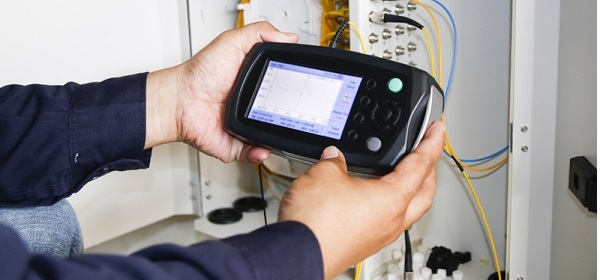
 Data Structure
Data Structure Networking
Networking RDBMS
RDBMS Operating System
Operating System Java
Java MS Excel
MS Excel iOS
iOS HTML
HTML CSS
CSS Android
Android Python
Python C Programming
C Programming C++
C++ C#
C# MongoDB
MongoDB MySQL
MySQL Javascript
Javascript PHP
PHP
- Selected Reading
- UPSC IAS Exams Notes
- Developer's Best Practices
- Questions and Answers
- Effective Resume Writing
- HR Interview Questions
- Computer Glossary
- Who is Who
What is the full form of TDR ?
What is TDR?
Time Domain Reflectometer (TDR)is used to identify problems with transmission lines and coaxial cables. In order to locate and measure the size of cable faults, breaks, splices, terminations, or other events throughout the length of a conductive cable, test equipment called time domain reflectometers (TDR) generates an energy pulse or steps on the cable.
For measuring cable length and identifying faults on nearly all types of cable, including twisted pair, coaxial, and parallel conductors, a TDR (Time Domain Reflectometer) is utilised. It is necessary to have access to two conductors from one end.

A Time Domain Reflectometer
The transmission line is scanned by the TDR for any reflections caused by an impedance mismatch using a low-voltage pulsed signal. If there is no impedance mismatch over the whole transmission line, reflections won't occur. However, if the transmission line is broken at a particular spot, a portion of the pulsed signal will be reflected back to the TDR. By observing the timing and propagation speed of the received pulse, the TDR may ascertain the exact location of the problem and the kind of fault, such as an open circuit, short circuit, or impedance mismatch.
Cable Fault Location:distance $(d)\:=\:\upsilon_{p}(\frac{t}{2})$
Where
D = the distance in metres.
Vp is the propagation velocity in metres per second.
T is the transit time in seconds from the monitoring point to the mismatch.
You may determine the type of mismatch by
$$ \mathrm{p\:=\:\frac{E_r}{E_i}\:=\:\frac{Z_l\:-\:Z_o}{Z_l\:+\:Z_o}}$$
Examples of common cable impedance increases that TDRs have detected
On a test coupon, TDR pumps a pulse onto the transmission line. The characteristic impedance is then determined by examining the variations in the amplitude of the reflected waveform. Keep in mind that TDR will only detect the reflections if the injected pulse encounters any route discontinuity.
Description
To locate problems in transmission lines and coaxial cables, a Time Domain Reflectometer (TDR) is a tool employed. The TDR scans the transmission line with a low-voltage pulsed signal to look for any reflections caused by an impedance mismatch.
Example traces
These traces were made using a time-domain reflectometer that was constructed from basic lab tools and linked to a coaxial wire with a characteristic impedance of 50 ohms that was about 100 feet (30 metres) long. This cable's propagation speed is roughly 66% of the speed of light in a vacuum.

A TDR connected to a server
How It Works?
Like radar, a TDR functions. At one end, the cable system is given a quick rising time pulse (near end). Any change in the characteristic impedance (impedance discontinuities) will cause some of the incident signal to be reflected back towards the source as the pulse travels down the wire.
Explanation
TDRs, or time domain reflectometers, are used to test cable systems and other feeder types and can identify and localise problems.
Time domain reflectometers, or TDRs, are therefore frequently employed in any situation where there may be lengthy or difficult-to-reach cables that need to be inspected or that may have defects. On printed circuit boards, time domain reflectometry can be utilised to find problems that may occur.
Usage
In order to locate faults in semiconductor device packages without causing any damage, time domain reflectometry is utilised in semiconductor failure analysis. To locate openings and shorts, the TDR, which gives an electrical signature of each individual conductive trace in the device package, is helpful.
In order to locate and measure the size of cable faults, breaks, splices, terminations, or other events throughout the length of a conductive cable.
In industrial contexts, the TDR principle is applied to a variety of tasks, from sensing liquid levels to testing integrated circuit packages.
Modern high-frequency printed circuit boards with signal traces designed to mimic transmission lines require the use of TDR equipment as a critical component of the failure investigation process.
Conclusion
In this article, we have learned about TDRs. TDR is an abbreviation for Time Domain Reflectometer, it is a device that sends a pulse and measures the time it takes for the pulse to be reflected back from a certain point. Using this device many optical fibers and other cables can be checked for breaks or terminations.
FAQs
Q1. What is the principle of TDR?
Ans. The TDR method calculates the speed at which a high-frequency signal travels via underground waveguides. The velocity and soil's dielectric constant are both correlated with its water content. Period and frequency are defined in terms of basic physics.
Q2. What are types of TDR?
Ans. Four different forms of TDR are typically produced
Slum TDR.
Heritage TDR.
Road TDR.
Reserved plots TDR.
Q3. How is TDR quantified?
Ans.This can be calculated using the formula: $\mathrm{L\:=\:t\:\times\:\frac{v}{2}}$ , where l stands for length, t for time, and v for velocity. The time it takes for the pulse to return is measured by the TDR device. The formula can be used to calculate the propagation velocity if the precise cable length is known.

